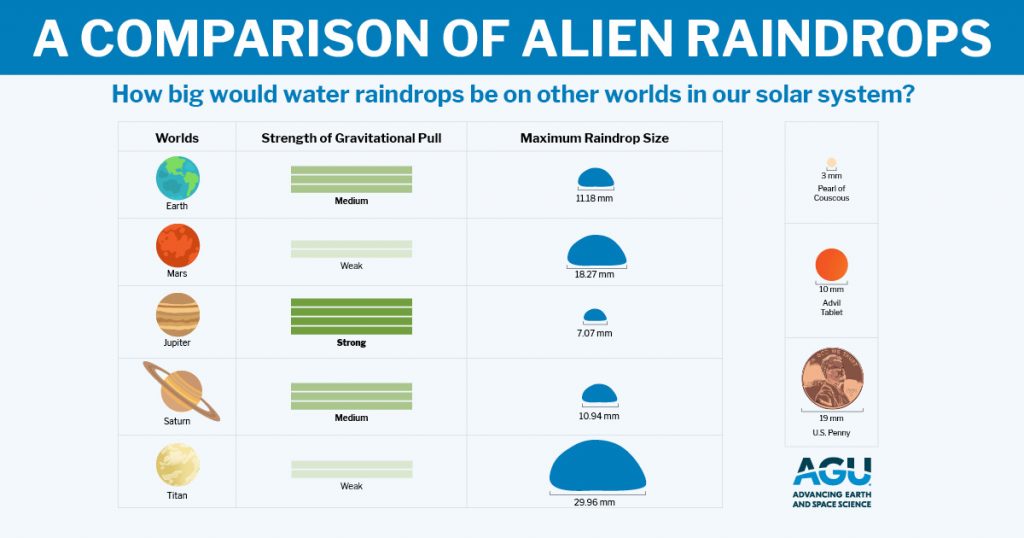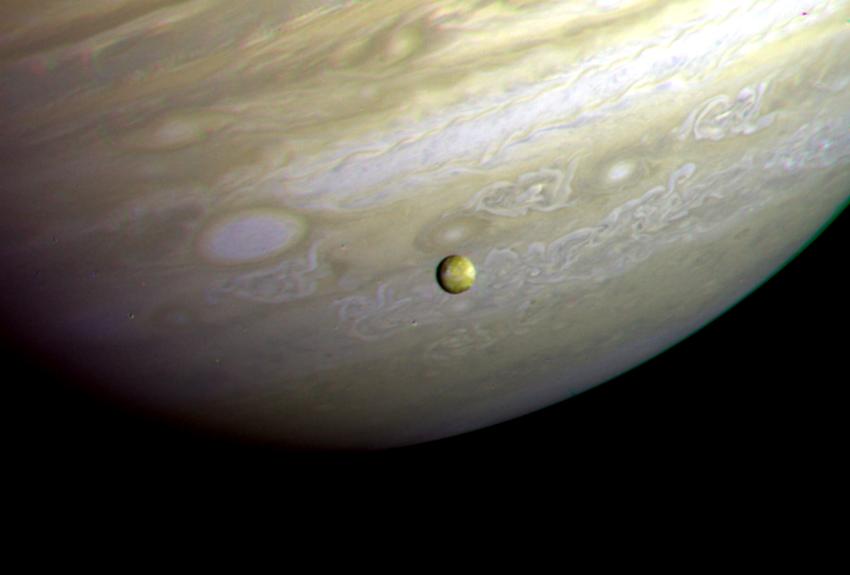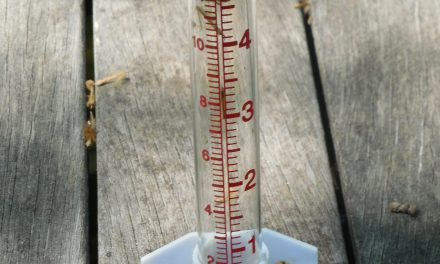According to new research, liquid precipitation behaves roughly the same throughout the galaxy — whether it rains water on Earth, ammonia on Jupiter, or liquified methane on Saturn’s moon Titan.
The new study, “The Physics of Falling Raindrops in Diverse Planetary Atmospheres,” published in the April 2021 edition of JGR Planets, proposes a set of equations astronomers can use to predict the shape, velocity, and evaporation rates of raindrops on other planets. The equations rely on basic atmospheric conditions like temperature, air pressure, and gravitational strength. Previous research has described extraterrestrial rainfall only on specific planets and under narrow conditions. However, the newly proposed model works from fundamental laws of physics transferrable to any atmospheric setting.
Using the equations, researchers can gain valuable information about any planet’s climate and nutrient cycle by leveraging what they know about the atmosphere and the liquids, or condensibles, in the planet’s precipitation, described lead author and Harvard University (Cambridge, Massachusetts) planetary scientist Kaitlyn Loftus.
“This is basically fluid dynamics and thermodynamics, which we understand very well,” Loftus told Science News in April. “All these different condensibles behave similarly [because] they’re governed by similar equations.”
Universal Physics
In general, the team’s model predicts that clouds on planets with stronger gravity typically produce smaller raindrops.
However, after applying their equations to the atmospheres of a range of planetary bodies both smaller and much larger than that of Earth, researchers discovered that all liquid precipitation trends toward a radius similar to water rain, averaging only as wide as a few millimeters per drop. This held true even when precipitation featured different condensibles. For example, iron-based precipitation on the gas giant WASP 76b — the largest raindrops identified in the study — averaged only about twice the radius of water raindrops on Earth.

To better understand whether condensible composition or atmospheric conditions had the larger effect on rainfall, researchers also used the model to simulate how Earth’s water-based rain might behave if it developed and fell through the atmospheres of other planets. According to the team’s equations, Jupiter’s strong gravitational pull would force the size of water-based raindrops down to nearly half of their size on Earth, while the weak gravity on Titan would produce water droplets about three times as wide. However, Jupiter’s ammonia-based raindrops and Titan’s methane-based raindrops are only about 11% and 26% smaller than Earth’s water-based raindrops, respectively, when they form on their home planets.
The finding makes technical sense, Loftus explained. As liquids pass through whatever gases make up the atmosphere in which they fall, drops that are too small tend to evaporate, while drops that are too large tend to split into smaller droplets.
“There’s a fairly small range of stable sizes that these different composition raindrops can have,” Loftus said in a release. “They’re all fundamentally limited to be around the same maximum size.”
Learning About Planets Through Their Rain
Many of the same datapoints the model uses to predict the size of extraterrestrial raindrops can help researchers infer their shape, terminal velocity, and evaporation rates, the study describes. Shape, for example, is an expression of the condensible’s mass, the air density of the planet, and its surface gravity, whereas evaporation rates depend on differences in temperature and humidity between the drop and the air around it.
By considering these factors together, researchers can use the model to piece together a comprehensive picture of a planet’s precipitation, a key component of understanding the planet’s climate and nutrient cycles.
The researchers caution, however, that this model alone cannot provide definitive conclusions about the climates of other planets. While the model reliably predicts how single raindrops behave after they have formed, it does not consider the more complicated processes by which condensibles accumulate in clouds before they become precipitation, how the quantity of raindrops might affect behavior, or the behavior of solid precipitation. According to the study, the team’s model represents “merely a first step toward a generalized theory of how precipitation and condensible cycles operate in planetary conditions different from modern Earth.”
Top image courtesy of U.S. National Aeronautics and Space Administration







